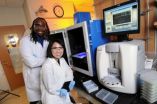Brain may 'see' more than the eyes, study indicates
2012-11-01
(Press-News.org) Vision may be less important to "seeing" than is the brain's ability to process points of light into complex images, according to a new study of the fruit fly visual system currently published in the online journal Nature Communications.
University of Virginia researchers have found that the very simple eyes of fruit fly larvae, with only 24 total photoreceptors (the human eye contains more than 125 million), provide just enough light or visual input to allow the animal's relatively large brain to assemble that input into images.
"It blows open how we think about vision," said Barry Condron, a neurobiologist in U.Va.'s College of Arts & Sciences, who oversaw the study. "This tells us that visual input may not be as important to sight as the brain working behind it. In this case, the brain apparently is able to compensate for the minimal visual input."
Condron's graduate students, Elizabeth Daubert, Nick Macedonia and Catherine Hamilton, conducted a series of experiments to test the vision of fruit fly larvae after they noticed an interesting behavior of the animals during a different study of the nervous system. They found that when a larva was tethered to the bottom of a petri dish, other larvae were attracted to it as it wiggled attempting to free itself.
The animals apparently saw the writhing motion and were attracted to it, willingly traveling toward it. After several further experiments to understand how they sensed the motion, the researchers learned that the nearly blind animals likely were seeing the action, by wagging their heads side-to-side in a scanning motion to detect it, rather than by only hearing it or feeling vibration or by smelling the trapped larva. This was a surprise because of the very simple and limited vision of fruit fly larvae.
"The answer must be in the large, somewhat sophisticated brain of these animals," Condron said. "They are able to take just a couple dozen points of light and then process that into recognizable images; something like when an astronomer with a small telescope is able to use techniques to refine a limited image into useful information about a star."
Condron believes the animals are able to assemble useful images by rapidly scanning their heads and, in so doing, gather up enough light points to allow the brain to compose a panoramic image clear enough to "see."
The researchers tested this by presenting larva with a video of a writhing larva (therefore no vibration, no sound and no smell) and found that the larvae still detected and sought out the struggling larva on the video. They also learned that if they slowed down or sped up the video, the larvae were less attracted or not attracted at all to the video larva. They also were not attracted to dead real larva, or to tethered larva of another species, and they also had difficulty finding tethered larva in near darkness.
"Apparently they are – to a very high degree – visually sensitive to detail and rate of motion and can recognize their own species in this way," Condron said. "This provides us with a good model for trying to understand the role that the brain plays in helping organisms, including humans, to process images, such as recognizing faces."
He noted that the head scanning apparently plays an important role in helping the larvae to bring together multiple visual inputs into a unified whole for the brain to process, similar to collecting together multiple pixels to form a picture. Condron said people with severe vision loss also tend to use head scanning as a means for collecting a "picture" from very dim light sources. Likewise, visually impaired people who have received experimental retinal implants of just a small number of pixels also often scan their heads to take in enough light to form mental images.
"It's easy for lab biologists to view fruit flies as simple animals that just feed and reproduce, but we are beginning to realize that that may be in contradiction to the big brain," Condron said. "There's more to what they are able to do than previously thought, whether using that brain for behaviors or for constructing images from a limited visual system."
He said the fruit fly serves as an excellent model for studying neurons because the animal has only about 20,000 of them, whereas humans have about 100 billion. Yet there are many similarities to how fruit fly and human neurons work. According to Condron, researchers are within a year of mapping the entire nervous system of the fruit fly, which then will pave the way for greater understanding of how neurons work in a range of organisms, including humans.
### END
ELSE PRESS RELEASES FROM THIS DATE:
IU researchers report first effective treatment of tumors arising from common genetic disease NF1
2012-11-01
Physician-researchers at Indiana University School of Medicine have reported the first effective therapy for a class of previously untreatable and potentially life-threatening tumors often found in children.
Announcing their findings in the online first edition of Lancet Oncology, the researchers said the drug imatinib mesylate, marketed as Gleevec as a treatment for chronic myeloid leukemia, provided relief to a significant number of patients with plexiform neurofibromas, tumors caused by neurofibromatosis type 1, or NF1.
"Although this was a small study, the results ...
Super-rare, super-luminous supernovae are likely explosion of universe's earliest stars
2012-11-01
The most-distant, super-luminous supernovae found to date have been observed by an international team, including Raymond Carlberg of the University of Toronto's Department of Astronomy & Astrophysics. The stellar explosions would have occurred at a time when the universe was much younger and probably soon after the Big Bang.
"The objects are both unusually bright and unusually slow to fade. These are properties that are consistent with what is known as pair-instability supernova, a rare mechanism for explosion which is expected to happen for high-mass stars with almost ...
Stem cells could heal equine tendon injuries
2012-11-01
Tendon injuries affect athletic horses at all levels. Researchers from the University of Connecticut are studying the use of stem cells in treating equine tendon injuries. Their findings were published Oct. 16 in the Journal of Animal Science Papers in Press.
Tendon injuries in horses tend to worsen over time as damage to the tendon creates lesions. Currently, horse owners treat tendon injuries by resting the horse and then carefully exercising the horse to control the growth of scar tissue in the tendon. Unfortunately, this treatment does not always work.
"These injuries ...
LSUHSC research identifies new therapeutic target for Alzheimer's disease
2012-11-01
New Orleans, LA – Research led by Chu Chen, PhD, Associate Professor of Neuroscience at LSU Health Sciences Center New Orleans, has identified an enzyme called Monoacylglycerol lipase (MAGL) as a new therapeutic target to treat or prevent Alzheimer's disease. The study was published online November 1, 2012 in the Online Now section of the journal Cell Reports.
The research team found that inactivation of MAGL, best known for its role in degrading a cannabinoid produced in the brain, reduced the production and accumulation of beta amyloid plaques, a pathological hallmark ...
Rethinking reading
2012-11-01
Many educators have long believed that when words differ on only one sound, early readers can learn the rules of phonics by focusing on what is different between the words. This is thought to be a critical gateway to reading words and sentences.
But scientists at the University of Iowa are turning that thinking on its head. A recent study published in "Developmental Psychology" shows certain kinds of variation in words may help early readers learn better. When children see the same phonics regularities, embedded in words with more variation, they may learn these crucial ...
Laser-light testing of breast tumor fiber patterns helps show whose cancer is spreading
2012-11-01
Using advanced microscopes equipped with tissue-penetrating laser light, cancer imaging experts at Johns Hopkins have developed a promising, new way to accurately analyze the distinctive patterns of ultra-thin collagen fibers in breast tumor tissue samples and to help tell if the cancer has spread.
The Johns Hopkins researchers say their crisscrossing optical images, made by shining a laser back and forth across a biopsied tissue sample a few millionths of a meter thick, can potentially be used with other tests to more accurately determine the need for lymph node biopsy ...
George Mason University researchers target breast cancer in 3 trials
2012-11-01
Fairfax, Va. -- A malarial drug is showing promise in stopping breast cancer before it starts, Mason researchers are discovering during a clinical trial.
"The bold long-term goal is a short-term oral treatment that prevents breast cancer by killing the precursor cells that initiate breast cancer," says Lance Liotta, co-director of Mason's Center for Applied Proteomics and Molecular Medicine (CAPMM). "And it's looking hopeful."
The PINC trial (Preventing Invasive Neoplasia with Chloroquine) targets ductal carcinoma in situ, or DCIS, the most common type of pre-invasive ...
Researchers use blood testing to predict level of enzymes that facilitate disease progression
2012-11-01
Predicting how atherosclerosis, osteoporosis or cancer will progress or respond to drugs in individual patients is difficult. In a new study, researchers took another step toward that goal by developing a technique able to predict from a blood sample the amount of cathepsins—protein-degrading enzymes known to accelerate these diseases—a specific person would produce.
This patient-specific information may be helpful in developing personalized approaches to treat these tissue-destructive diseases.
"We measured significant variability in the amount of cathepsins produced ...
Mice with 'humanized' livers improve early drug testing, Stanford scientists show
2012-11-01
STANFORD, Calif. — Stanford University School of Medicine scientists have used bioengineered mice with livers composed largely of human cells to characterize a drug about to enter early-stage clinical development for combating hepatitis C.
Tests using the new mouse model accurately predicted significant aspects of the drug's behavior in humans — including its interaction with another drug and the profile of its major breakdown products in the body (called metabolites) — far more accurately than would have been achieved using current methods.
The study will be published ...
Regional analysis masks substantial local variation in health care spending
2012-11-01
PITTSBURGH, Oct. 31, 2012 – Reforming Medicare payments based on large geographic regions may be too bluntly targeted to promote the best use of health care resources, a new analysis from the University of Pittsburgh Graduate School of Public Health suggests. The analysis will be published in the Nov. 1 issue of the New England Journal of Medicine.
"Much policy attention has been drawn to the large geographic variation in health care spending across regions, and for good reason – because regional variation points to inefficient use of resources," said lead author Yuting ...


